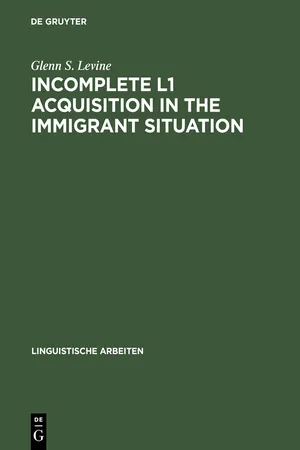
eBook - PDF
Incomplete L1 Acquisition in the Immigrant Situation
Yiddish in the United States
- 112 pages
- English
- PDF
- Available on iOS & Android
eBook - PDF
About this book
This monograph establishes a theoretical model for the investigation of 'incomplete L1 acquisition' in the immigrant situation. The study focuses on the linguistic behaviour of elderly speakers who acquired Yiddish simultaneously with English and have not used the language since childhood. The central question is whether ungrammatical forms in the data can be traced to the attrition of forms once acquired or to the incomplete acquisition of those forms. With regard to Yiddish present perfect rules, results favor the latter explanation, indicating long-fossilized, divergent child language.
Frequently asked questions
Yes, you can cancel anytime from the Subscription tab in your account settings on the Perlego website. Your subscription will stay active until the end of your current billing period. Learn how to cancel your subscription.
At the moment all of our mobile-responsive ePub books are available to download via the app. Most of our PDFs are also available to download and we're working on making the final remaining ones downloadable now. Learn more here.
Perlego offers two plans: Essential and Complete
- Essential is ideal for learners and professionals who enjoy exploring a wide range of subjects. Access the Essential Library with 800,000+ trusted titles and best-sellers across business, personal growth, and the humanities. Includes unlimited reading time and Standard Read Aloud voice.
- Complete: Perfect for advanced learners and researchers needing full, unrestricted access. Unlock 1.4M+ books across hundreds of subjects, including academic and specialized titles. The Complete Plan also includes advanced features like Premium Read Aloud and Research Assistant.
We are an online textbook subscription service, where you can get access to an entire online library for less than the price of a single book per month. With over 1 million books across 1000+ topics, we’ve got you covered! Learn more here.
Look out for the read-aloud symbol on your next book to see if you can listen to it. The read-aloud tool reads text aloud for you, highlighting the text as it is being read. You can pause it, speed it up and slow it down. Learn more here.
Yes! You can use the Perlego app on both iOS or Android devices to read anytime, anywhere — even offline. Perfect for commutes or when you’re on the go.
Please note we cannot support devices running on iOS 13 and Android 7 or earlier. Learn more about using the app.
Please note we cannot support devices running on iOS 13 and Android 7 or earlier. Learn more about using the app.
Yes, you can access Incomplete L1 Acquisition in the Immigrant Situation by Glenn S. Levine in PDF and/or ePUB format, as well as other popular books in Languages & Linguistics & German Language. We have over one million books available in our catalogue for you to explore.
Information
Table of contents
- Preface and acknowledgements
- 1 Goals and theoretical framework
- 1.1 Introduction
- 1.2 Contents of this monograph
- 1.3 Child language acquisition: Assumptions
- 1.4 Bilingual L1 acquisition
- 1.5 Language death, L1 attrition, and incomplete L1 acquisition
- 1.6 Linguistic studies dealing with speakers of Yiddish
- 1.7 Summary
- 2 The study
- 2.1 Introduction: Inherent problems in the study of obsolescent languages
- 2.2 The population
- 2.3 Pilot studies
- 2.4 The sample
- 2.5 Locating informants
- 2.6 Primary informants
- 2.7 Additional informants
- 2.8 The interview
- 2.9 Data analysis
- 2.10 Summary
- 3 The language of incomplete L1 acquisition in the immigrant situation
- 3.1 Introduction
- 3.2 Proficiency continuum and personal-pattern variation in informants’ Yiddish
- 3.3 What sort of speakers of Yiddish are primary informants?
- 3.3.1 Are primary informants semi–speakers of Yiddish?
- 3.3.2 Are primary informants native speakers of Yiddish?
- 3.4 Characteristics of primary informants’ Yiddish
- 3.4.1 Phonological performance of primary and secondary informants
- 3.4.2 Compensatory narrative/discourse strategies
- 3.4.3 Scope and semantic characteristics of informants’ lexicon
- 3.4.4 Intrasentential codeswitching
- 3.4.5 Verbal morphosyntax
- 3.4.6 Nominal morphosyntax
- 3.5 Summary
- 4 Social and sociolinguistic factors in the incomplete L1 acquisition of Yiddish among primary informants
- 4.1 A sociolinguistic model of incomplete L1 acquisition in the immigrant situation
- 4.2 Speaker practice: Inadequate exposure
- 4.2.1 Inadequate exposure: Limited domains and registers
- 4.2.2 Inadequate exposure: One-way vertical communication
- 4.2.3 Inadequate exposure: Early termination of active use
- 4.3 Attitudes toward L1
- 4.4 Linguistic identity
- 4.5 Summary
- 5 Evidence of incomplete L1 acquisition in primary informants’ speech: Choice of auxiliary in the present perfect tense
- 5.1 Introduction
- 5.2 The present perfect tense in Yiddish and other Germanic languages
- 5.3 Primary informants’ use of the present perfect
- 5.4 Secondary informants: ‘Full acquisition’ speakers of Yiddish with L1 attrition
- 5.5 Bilingual and monolingual L1 acquisition
- 5.6 Bilingual L1 acquisition of German and English: Leopold (1970/1939–1949)
- 5.7 Bilingual L1 acquisition of German and English: De Houwer (1990) and the role of the dominant language
- 5.8 Conclusion
- 6 Conclusion
- 6.1 Summary of this monograph
- 6.2 Implications of the study
- 6.3 Directions for further research
- References
- Index